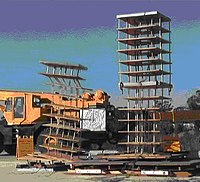
Photo from wikipedia
Abstract The aim of this work is to present a simple and practical experimental technique for the estimation of the ultimate shear capacity of perforated in-plane loaded dry joint masonry… Click to show full abstract
Abstract The aim of this work is to present a simple and practical experimental technique for the estimation of the ultimate shear capacity of perforated in-plane loaded dry joint masonry panels. The test is carried out by using a tilting table; in-scale models of several different perforated walls are assembled and positioned on the tilting table. The table is progressively tilted in quasi-static conditions, in order to reproduce the action of a static horizontal load proportional to masses. As a result, the model collapses for a given tilting angle, which represents the ultimate destabilizing horizontal action. The experimental setup was applied to a series of seven different masonry panels, conceived by different University teams from different countries in the context of a student competition proposed in the occasion of the 10th international Masonry Conference (10th IMC), held at the Technical University of Milan from 9th to 11th July 2018. The aim was to design a running bond shear panel with established height over length ratio, a minimum perforation ratio equal to 30% of the area and clay bricks with given dimensions disposed in either stack or running bond. The winning team was that obtaining the largest inclination angle of the tilting plane activating the collapse of the structure. Three replicates of the same experimental test were repeated in the lab of the Technical University of Milan to reduce experimental scatter of the results. In this paper we present and discuss the outcome of the experimentations carried out, in view of analyzing such results with sophisticated limit analysis approaches in the second part of the paper. The test requires simple and inexpensive instrumentation and can be adopted for a reliable prediction of the behavior of perforated shear walls in-plane loaded, assembled with dry joint bricks and horizontally loaded.
Journal Title: Engineering Structures
Year Published: 2021
Link to full text (if available)
Share on Social Media: Sign Up to like & get
recommendations!